|

|
Community mobilisation: A systems-view:
A community is a group of people who form relationships over time by interacting regularly around shared experiences, which are of interest to all of them for varying individual reasons. What makes community more than a simple group of people is that they are drawn together around some object. This object can be physical, virtual, theoretical, or philosophical; a political ideal, etc. The community is important in that it contributes to individual and social well being by establishing and maintaining channels of communication, organizing resources to meet local needs, and providing a framework where the collective is more than the sum of its parts.
Community development is the process by which people living in a community identify common goals and work together to achieve those goals. Community mobilisation is a process of engaging communities through participatory methodologies with the objective of giving them the confidence to take responsibility for identifying potentials and solving problems that hinder them from tapping existing potentials. It is important to move away from only talking about “problems” towards a discussion about existing or latent potentials. This adds a positive dimension to development (behind every problem there is a potential). Community mobilisation empowers women and men to organize their own democratically self-governing groups or community organizations, which enable them to initiate and control their own personal and communal development, as opposed to mere participation in an initiative designed by the government or an external organization.
|
|

|
The interaction of the “community” can be viewed in form of a “system”, the components need to be balanced and working in harmony with each other:
- Social components includes the communities own culture, values, traditions and norms and it depicts the way the community sees itself. Social component of the community results from the exchange of ideas and information within the community over time. This is not a static but rather a dynamic process. Changes take place over time, but members of the community change, people come and go bringing with them new ideas and information. Social aspects of the community are intangible they form the heart of the community process.
- Political component of a community is defined by the way in which the community is organised to manage itself. It includes legal contracts between individuals, laws, rules and regulations. It includes elected and non elected governments, civic groups, religious and charitable organizations, clubs, associations, families and friends. The political component regulates the community’s social system as well as the way in which the economic aspects of a community functions, including how the community produces, distributes, and consumes resources
- The economic component of the community “system” is made up of both tangible and intangible factors, it is necessary in order to ensure that a community can actually survive. Economic component includes the exchange of resources between and amongst community members. Economic component requires the social and political component in order to provide the rules for the exchange of resources.
- Built or natural environment defines or describes the spatial area in which the community lives. The built environment includes cities, towns, villages and settlements while the natural environment includes forests, savannah, lakes, rivers. The spatial area has an enormous bearing on the way in which the community develops since it defines the resources available to the community (natural resources that are required for production, include land and water).
- Time is an important variable amongst all the components making up the community “system”. Three separate times exist: past, present and future. The past is important for the community, it often defines how community has developed and the also should be seen a forming the knowledge-base of a community. A community’s history is a critical part of its existence. Its influence is quite often not even seen, let alone understood. History shapes actions both today and in future. Day to day events are tangible accounts of the present, they interpret the past and define the future. A community also exists in the future. The future can be planned or experienced.
Figure 1: Five components of community mobilisation “systems-view”
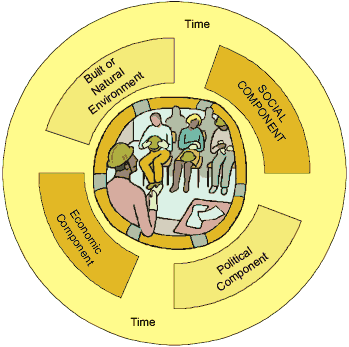
|
 |
Putting it all together
The community components making up the “system” need to be mobilised in order to ensure that development can take place. Mobilisation is the process of getting the people in a community to empower themselves as well as to work together as a group to tackle common issues. Ideally, the process involves all members of the community, however, it may also require some members of the community to take the lead in the process and to act as innovators since the entire community gains or loses through the action of any member of the community. Community development often makes use of the inherent optimism of human beings by providing a mechanism through which positive futures can be achieved. This optimism can only be tapped by moving away from the traditional “problem solving and prevention” towards “potential development and enhancement”, there is a need to think-positive.
Who should certify?
Self-regulation versus Governmental control
Self-regulation by organisations involved in promoting community mobilisation offers the least bureaucratic approach for certifiying stages of mobilsiation. Non-governmental organisations and training institutions would jointly define the necessary “standards” and the organisations would then internally ensure that they adhere to these standards.
Government regulation is likely to take longer to achieve in addition it will tend to be buerocratic and possibly also inflexible. Embedding it in specific decrees or even in laws (e.g. in decentralisation laws) would have the advantage of formalising the process. A purely governmental certification process could marginalise non-governmental organisations promoting mobilisation.
A self-rgulatory process that includes active involvement of the government is the most favoured option. Defining the most suitable institution / organisation to undertake the certification process is an important first step in the process.
Central task of the organisation is to develop “code of conduct” along which all institutions agree they will abide by. This would also include elaborating a mechanism how the the defined quality standards will be adhered to and measured. Such a process can be initiated by a non-governmental organisation, a local government, or national governmental organisation. Important is that agreement is reached among all that a unified certification process with agreed upon indicators should be established. This may eventually be transformed into a decree or law eventually.
|
| |
Step 1: Defining levels of mobilisation
It is not realistically possible for communities to become mobilised within a relatively short period of time. Time frames quoted as being necessary for mobilisation range from a few days to many years. It depends on many different factors, many of which have been touched upon in the previously depicted systems view (culture, time, levels of social development, level of political development). The definition of successful mobilisation is a gradual process made up of different levels: from embryonic to maturity. Success requires the definition of quality standards that define the achievement of a particular stage of mobilisation. The standards have to be defined and agreed upon, the most effective approach is to use the definition of a minimum basic standard.
The basic logic of the approach is based upon the hypotheses that there are fundamental attributes which any mobilised community has to have to be able to operate effectively . These basic attributes are independent of the function of the group. All groups, whether it is a water users group, a community health group or seed-growers group require similar capabilities to function.
Two approaches for determining levels of mobilisation are presented as examples. The “participation ladder” provides a basis for measuring the capabilities of the people who make up the groups. The stages define what communities are able to do (compare figure 2). The second example focuses more on what the organisations are able to do (compare the stages defined in table 2). The criteria assess organisational characteristics rather than social competencies.
The two approaches not mutually exclusive and they are designed to provide ideas for a certification process. Clearly these will vary from country to country and will be dependent upon the framework conditions. Graduation from one stage to the other is dependent upon the group able to undertake increasingly more complex functions. Ability to achieve these functions on a sustainable basis has to be verified through a quality assurance system.
Table 1: Typologies based upon either what the community or the organisation can do
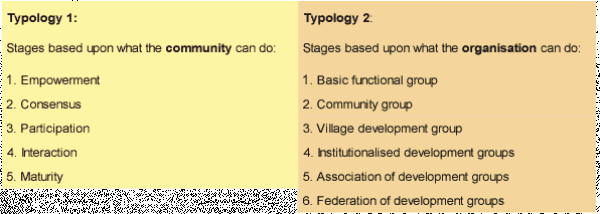
Figure 2: Stages of community mobilisation on the basis of what the people in a community can do
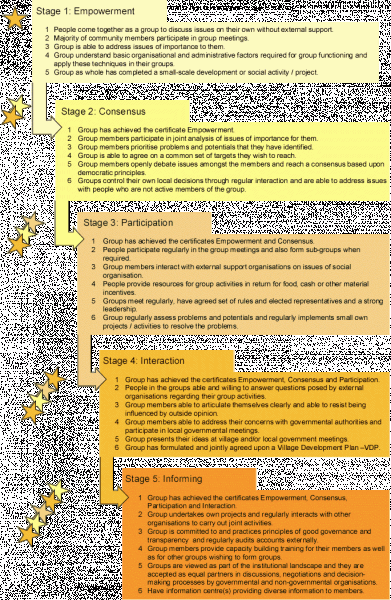
Table 2: Stages of community mobilisation based upon organisational criteria
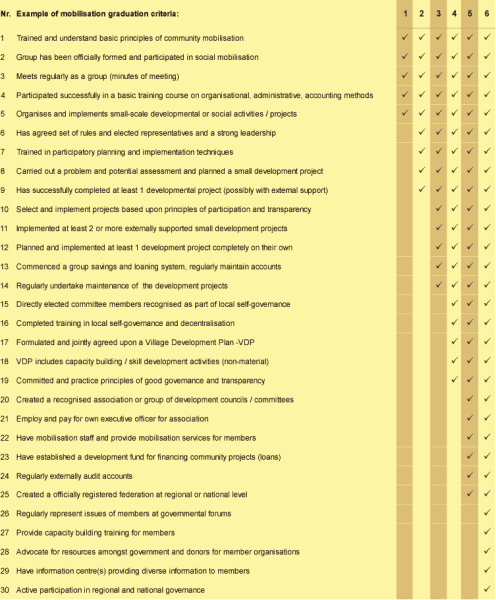
|
| |
Step 2: Quality assurance system
Quality management systems are designed in order to meet the quality standards laid down by the management of an organization. It includes the organizational structure, responsibilities, processes and resources required to meet these basic minimum quality standards. The most important concept that has to be introduced to an organization / institution is the establishment of a quality culture that is enshrined in a set of commonly agreed upon standards and principles and in order to ensure their compliance a system for monitoring, maintaining and steering has to be put into place.
Quality steering, quality assurance and quality improvement forms a continuous learning and self-improvement cycle. Institutions defining the quality criteria certify whether communities and institutions that assist in the mobilisation process adhere and comply with the defined standards. At the institutional level assistance, advice and support needs to be provided and this will be necessary in order to assist either the partner organisations or the communities themselves to reach the minimum standards. Together all elements in figure 2 represent the Quality Management System.
Figure 3: Systematic quality assurance approach
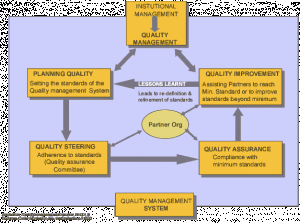
|
| |
Step 3: Defining a performance scale
- A scoring system has to be developed and agreed upon that is universal to all quality assurance questions that may be posed.
- It is important to agree upon the terminology of the scoring system first prior to defining the standards to be fulfilled.
- The main question is to what extent the quality standard or criteria of the standard have been met that has been defined in table 1.
- Table 2 defines the ranking process to achieve the minimum standard, namely 3.
Table 3: Quality standards and definition of minimum standard
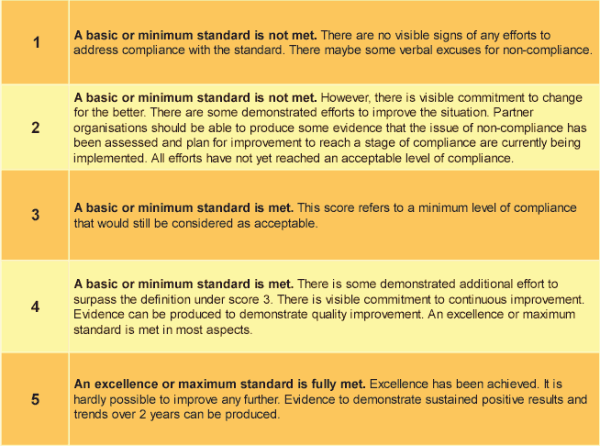
|
| |
Step 4: Defining minimum standard for each criteria
Each criteria depicted in either figure 1 or table 2 requires a clear set of indicators that can then be used to determine whether the minimum level has been achieved. The indicators must independently verifiable, they must be unbiased (i.e. free from social, cultural or behavioural interpretation), they must be measurable.
Each criteria or indicator should be equated to a training or capacity building module. What is important is that the training module should be “modular” and should be independent of each level of graduation. If a community has reached level 2 and wishes to “graduate” to level 3 or even level 4 an appropriate training curricula needs to be available which will ensure that the community are trained in the necessary skills. However, completion of the training does not represent successful achievement of the criteria, this is only possible once the processes and approaches that have been trained are sustainably applied by the communities.
Step 5: Defining the indicators
Indicators for the criteria need to be described in a short and precise statement. The indicator needs to measure the result that will be achieved. The skills required and the minimum quality standards that are to be fulfilled have to be defined for each of the thirty criteria depicted in table 1. Table 3 presents an example of five criteria used to determine whether a group has achieved stage 1 of the mobilisation approach.
The criteria and indicators need to be evolved for each country separately. The criteria and the minimum standards need to be defined specifically for the conditions prevalent in the respective country. Both the criteria and the indicators used in the tables are to be viewed as examples.
Table 4: Mobilistion criteria and their minimum level of achievement
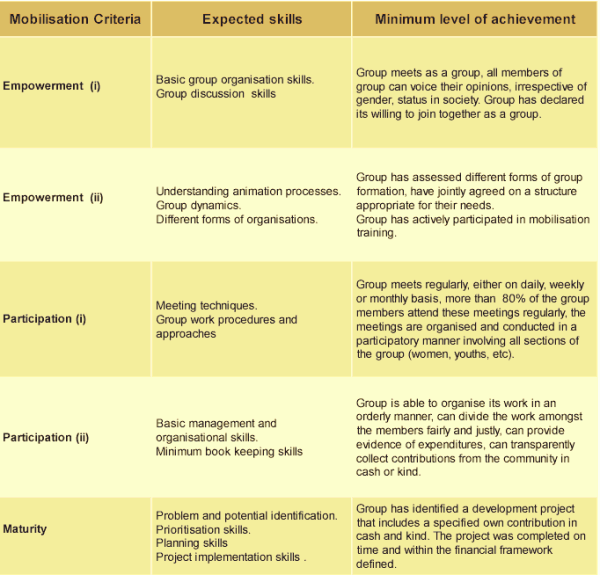
|
| |
Step 6: Training curricula and syllabus
After the criteria and the graduation process has been agreed to, the next step involves defining a training curricula and syllabus for each of the 6 main graduation steps. What is important is that the communities can progress from one status to the other if they have been appropriately qualified and trained and more importantly if they actually meet the minimum criteria.
- The approach allows some communities to progress quickly, others that require more intensive mobilisation can also complete their graduation process according to their own skill levels.
- The approach also allows national governments to define standards of mobilisation.
- Implementing organisations know what types of community mobilisation skills they require in order to jointly implement development programmes with the communities.
|
 |
Step 7: Train and certify training organisations and institutions
Training institutions and organisations who will be undertaking the capacity building of the communities also need to have the necessary standards to be able to undertake the training. The quality of training also needs to be certified. This ensures that the community actually receive standardised and quality assured training.
|









